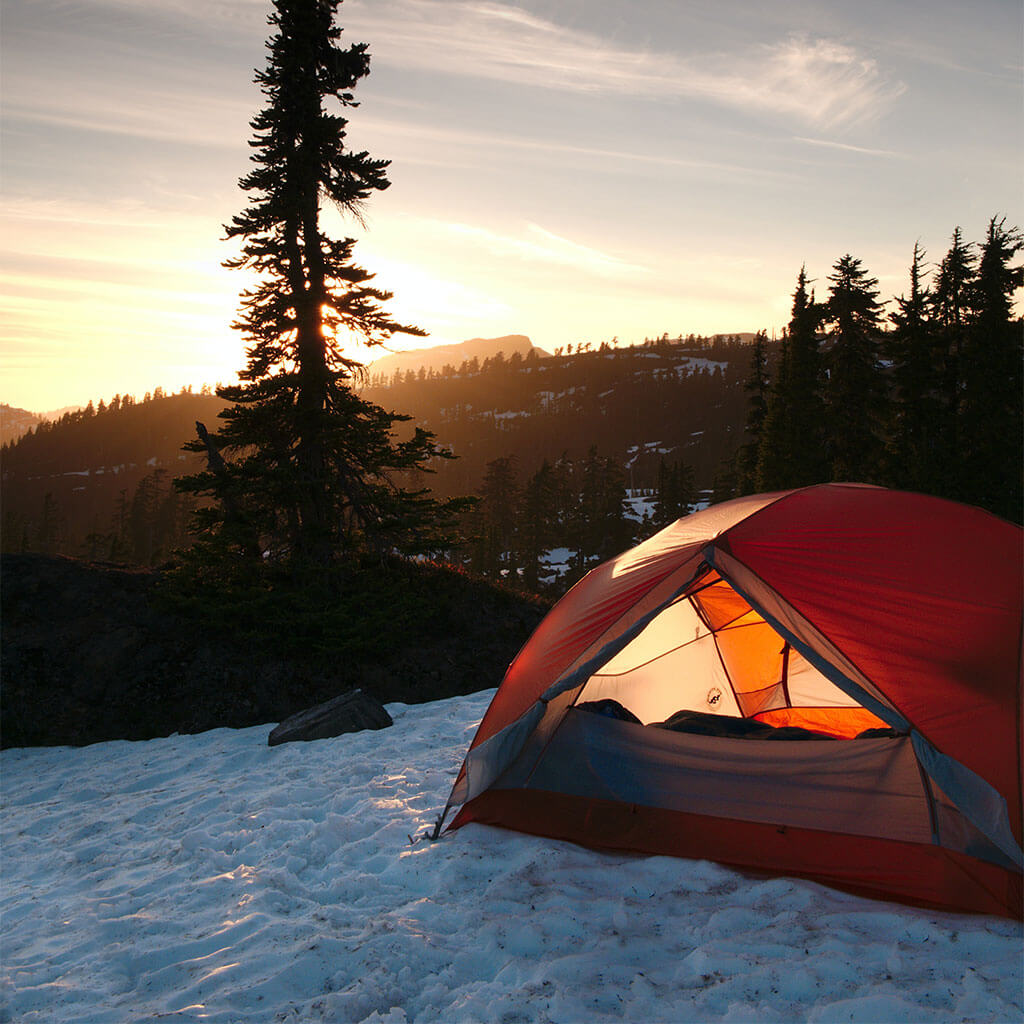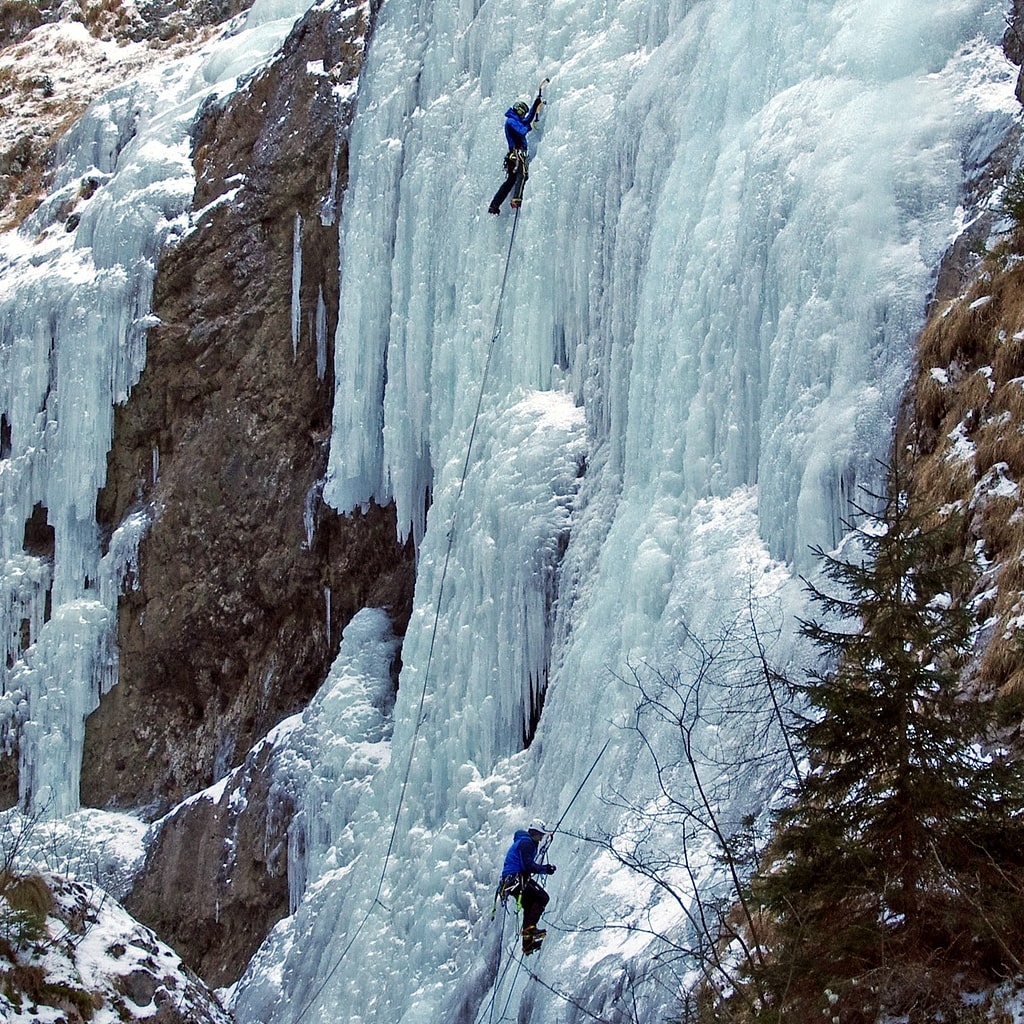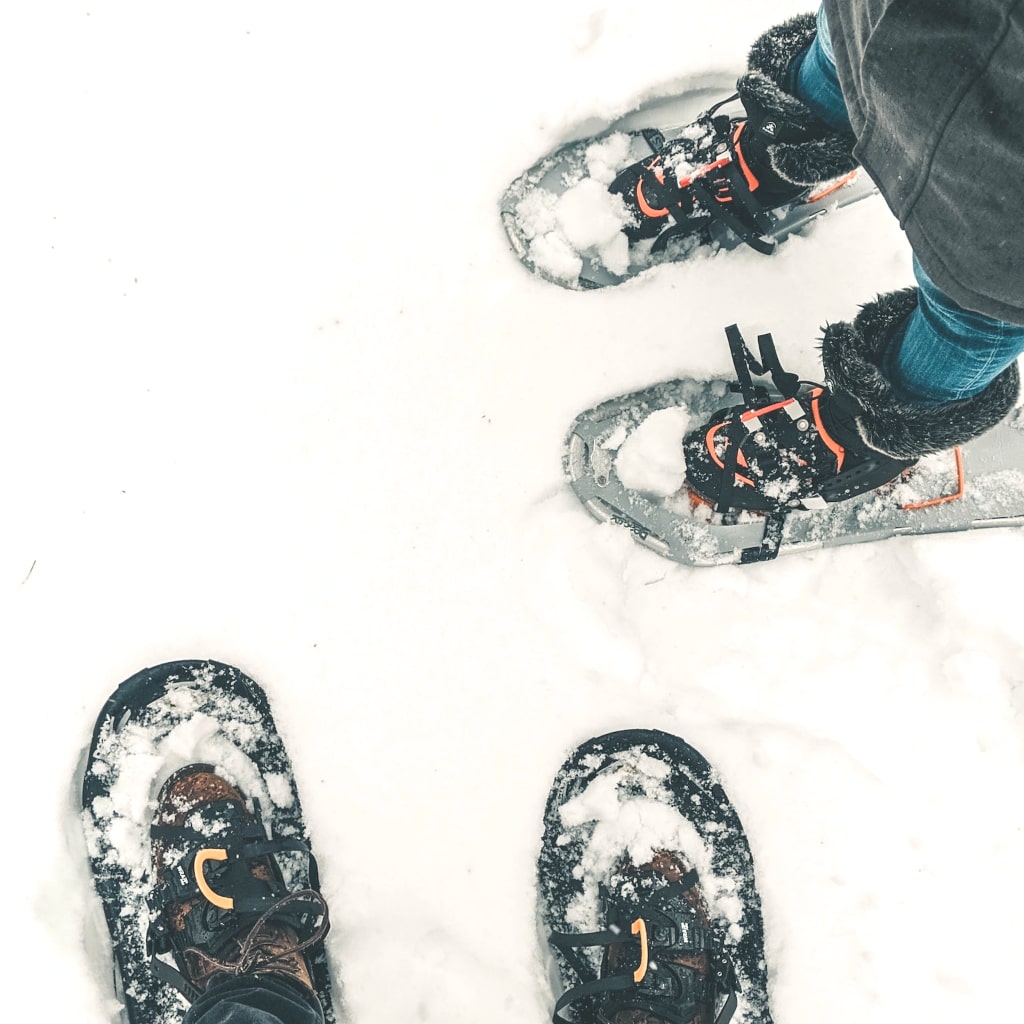Inspired for an Adventure? Check out Beef Stroganoff - Pouch and Beef Stew - Pouch
Add description, images, menus and links to your mega menu
A column with no settings can be used as a spacer
Link to your collections, sales and even external links
Add up to five columns
Add description, images, menus and links to your mega menu
A column with no settings can be used as a spacer
Link to your collections, sales and even external links
Add up to five columns


If you’re an outdoors enthusiast who’s never gone winter camping, you’re in for a treat! The “off-season” can be a fantastic time to be out and about in the backcountry. For one thing, destinations thronged during summer and early fall tend to be quiet and uncrowded in the clutch of Old Man Winter. Single-digit cold and muffling snow can make a pocket of close-to-home woods that’s busy as heck in August feel (deliciously) like deep wilderness. Furthermore, wintertime scenery gives the more verdant splendor of other seasons a run for its money: pristine drifts in a freshly whitened conifer forest, snow banners off a windswept high peak, the meander of a half-frozen river across a meadow flat so powdered it looks like a sheet of frosting… Wildlife, too, can be easier to detect in winter: Deer and elk gather into bigger, more visible herds, bald eagles congregate around fishable open water, and the overall snowscape makes one vast canvas for animal tracking. Long story short, there’s a whole lot of allure to winter camping. No question, though: It’s a different proposition than a warm-weather trek. Let’s run through a few of the basics of camping in the cold: from staying toasty in your frigid playground to choosing the right sort of snacks!
Cold Weather Camping Checklist
For the most part, the following cold-weather camping checklist focuses on items more specific to winter recreation; we won’t be covering everything you’d want to pack. These winter-camping essentials should give you a sturdy starting point, though.
Basic Equipment
- Four-Season Tent: Sure, a three-season model might do in an area with milder winter conditions, but for the most part you want to go for the big guns when camping in the cold. A four-season (or mountaineering) tent gives you a more rugged frame against the pumped-up winds of winter, keeps you better insulated with its solid walls, and provides more sheltered space—inside as well as within a vestibule or two—for keeping gear out of the elements.
- Sleeping Bag: It’s best to select a sleeping bag that’s rated at least 10 degrees Fahrenheit colder than the minimum temperatures you’re anticipating on your camping trip.
- Sleeping Pad(s): A thick inflatable sleeping pad’s definitely worth its extra weight when you’re camping in winter. It’s also a good idea to pack a second pad as well, such as a cheaper foam version: Stack this one atop the first pad to provide extra insulation when sleeping, and use it as a convenient mat for sitting or sorting gear around a snowy campsite.
- Backpack: You'll generally want a larger-capacity backpack for winter recreation to accommodate extra clothing and other supplies as well as bulkier gear. A 70- or 80-plus-liter bag works best for multiple nights camping in the cold.
- Folding or Telescoping Shovel: So you may well pack a shovel for you-know-what purposes, but the tool also comes in handy for scooping out a snowpack nook for your tent or camp kitchen, gathering snow for melting water, and other tasks. It's also essential for constructing a snow shelter in the event of an emergency.
Other Useful Winter-Camping Gear
- Cross-Country Skis or Snowshoes: Many a winter camper relies on skis or snowshoes to get around, given how much more efficient they are than slogging and staggering through the drifts. They can also function as deadmen-style weights for anchoring your tent when frozen ground or deep snow prevents staking.
- Ice Axe & Crampons: These aren’t just for mountain climbers: Winter trekkers, in general, may find them useful for negotiating crusted hillslopes and other challenging glazed-over countryside.
- Sled: Embrace your inner husky and tote a sled: It’s a great way to haul around the extra and heavier gear demanded by winter camping. Obviously use your discretion when it comes to the terrain you’re expecting to journey through: A sled becomes a drag (pardon the pun) in dense, deadfall-stacked woods, to say the least.
- Whisk Broom: This little tool can be a lifesaver when it comes to brushing clothes and boots free of snow before bringing them into your tent—and for clearing a freshly powdered or frosted rainfly.
- Bivy Sack: Some gritty types prefer bivy sacks to tents, but these lightweight shelters can also be used in conjunction with tents as added protection from damp and cold. They also make sleeping in snow shelters more comfortable. If you go camping in winter frequently and for extended periods, you might consider packing a bivy sack as emergency gear in case you need to abruptly hunker down, or if you expect particularly nasty conditions during your trek.
- Waterproof Stuff Sacks: These are useful for stowing boots and other wet/snowy gear in within your tent as well as keeping supplies dry.
Clothing Checklist
The basic principle of your winter-camping wardrobe? The same as your summer-camping one: layering, layering, layering. You’ll want a moisture-wicking, long-sleeved baselayer (e.g., polyester or merino wool), a fleece midlayer (such as a vest or sweater), and an outer shell such as a puffy jacket—with another waterproof shell packed along for when the skies turn nasty. Other winter-camping clothing essentials include a wool hat—you lose quite a lot of heat through your head, as your mother may have told you—as well as gloves and/or mittens. Mittens outshine gloves warmth-wise, but pack a pair of the latter in addition for carrying out around-the-camp tasks demanding dexterity. Choose synthetic or wool socks to better manage moisture. Some opt to wear two pairs of socks: a liner-style one against the skin to wick moisture, and a thicker wool sock on the outside for warmth and cushioning. Waterproof boots are best for winter camping, and consider those with removable liners. If you’re skiing, snowshoeing, or otherwise planning on traveling over snow, consider plastic boots. Wear gaiters to keep snow and ice out of your footwear—and to give you a little extra warmth. And bring along an extra pair of wool socks specifically for sleeping in: Your toes'll thank you.
Managing the Outfit
Layering gives you the more precise control over thermoregulation, especially critical during a wintertime adventure. To avoid chilling yourself due to excessive sweating, shed layers as you hike; your hat and gloves can be cycled on and off without having to stop and fumble in your pack. When you stop for a break or to make camp, you may well be warmed from exertion. Throw that midlayer or shell on right away, though, to avoid becoming chilled: You don’t want to make your body work harder to warm back up.
Eating & Cooking
All things considered, you can go a little overboard in the food department on a winter camping trip—especially a backpacking outing. Snack frequently on fatty and carb-rich fodder, from nuts to cheese to chocolates: Your body’s burning through a lot of energy not just hiking, skiing, or snowshoeing, but in simply staying warm, so you want to keep the fires well stoked. To each his or her own, but it’s often a better idea to eschew lunch stops in order to preserve warmth and, instead, simply nibble more often on the trail. The fast and cold onset of night during a winter camping trip means you don’t really want to be fussing around with overly complicated dinner prep and cooking. The same goes (and then some) on a subzero morning when you’re huddled in the sleeping bag waiting for the sun to finally crest the ridge. Conserving fuel’s also a priority, especially if you’re using it to melt snow for water, too. All this means quick, easy one-pot meals are the way to go. On that count, you can’t beat Mountain House breakfasts and entrees: Just add hot water, and you’ve got a hearty, steaming feast right in front of you—no fuss, no muss! Our freeze-dried meals also, of course, have the advantage of conserving fuel, given how quick they are to prepare. Here’s a tip from polar explorer Eric Larsen, passed along by Backpacker: On an extended foray into the winter wilderness, he recommends adding 40 grams of butter to each meal for extra energy. (A word of advice: Remember to discontinue that regimen once you get back home…) Stake out a sheltered spot around the campsite: in the lee of a boulder or tree, for instance, or one that you’ve buffered with a snow wall. In truly ferocious conditions, you can, with caution, cook in your tent’s vestibule.
Water
Drink plenty of water when camping in the winter. Strenuous physical activity in the season's dry air dehydrates you quickly. When the mercury’s hovering around freezing—or plunging far below—you’re faced with the challenge of keeping your on-the-go water supply thawed out. Use an insulated thermos or swaddle your water bottle in a wool sock. If you’re using a hydration tube, take measures to prevent freezing. If you’re planning on melting snow for water, keep in mind you’ll need to carry that much more stove fuel: Backpacker suggests eight ounces or more of white gas per person per day. Don’t forget to add a little water to a potful of snow before heating it; that way you’ll avoid a scorched taste to your meltwater. It’s more efficient to melt ice than snow, as the former claims the higher water content. In either case, be sure to bring the meltwater to boiling or otherwise treat it, as even the purest-looking powder may contain pathogens.
Miscellaneous Cold-Weather Camping Tips
Your Wintry Campsite
Thoughtfully selecting a campsite’s important any time of year, of course, but it takes on special importance in winter, when a poorly chosen spot may subject you to dangerously cold or otherwise inclement conditions. Avoid camping within hollows, canyons, or small valleys, as these collect cold air at night. Seek out campsites as sheltered as possible from the prevailing wind; you can also construct a snow wall in the windward direction if natural windbreaks aren’t available. (If you’re establishing a winter base camp and the conditions allow, you might consider building an igloo or some other protective snow shelter—though it goes without saying that care must be taken to avoid cave-ins.) If you’re on a slope, aim your tent door downhill. Tamp out a spot for your tent with snowshoes or skis, or excavate one with a shovel. The snow base beneath will tend to compact and freeze, so you want to make sure you create as flat a surface as you can from the get-go. A tarp, tent footprint, or other groundsheet helps keep things drier inside. Dig out a shallow pit in front of the tent door to serve as a nook for getting in and out of boots.
In the Sleeping Bag
Besides socks, you may end up wearing your hat and gloves to bed on colder nights. For extra warmth, use the tried-and-true trick of putting a bottle of hot water or a heat pack inside the bag. Nestle the next day’s garments into the bottom of the bag to keep it warm. You can even stuff your boots into a sack and do the same with that so that you aren’t jamming your feet into cold, stiff footwear first thing in the morning: not a pleasant kickoff to the day.
Don’t Forget to Minimize Your Impact
Minimize your impact on the landscape when you’re camping in winter, just as you do any other season. As much as you can, travel and camp on snow. Use a stove rather than a campfire (although make sure you have fire-starting materials for emergencies). Pack out all garbage; consider doing the same for solid human waste.
Camping in Winter: An Addictive Pursuit
Many outdoors people who give camping in the cold a shot find themselves utterly seduced by the activity. Begin with baby steps: Try a shoulder-season campout in autumn or spring to become accustomed to colder conditions, and consider joining an organized winter-camping outing to learn the ropes firsthand from an expert. And don’t forget your Mountain House meals for super-convenient dining out in the snows…
A Beginner’s Ice-Climbing Guide: How to Get Started

15 Best Places To Go Snowshoeing in North America This Winter


Stay Hungry for Adventure
Sign Up for Delicious Outdoor Meals & Exclusive Offers!
By clicking ‘Join Now’, I agree to the Terms of Service and Privacy Policy.


Join the adventure
©2025 Mountain House — All Rights Reserved.
Your Cart is Empty
Continue ShoppingYour Cart
Subtotal
$0.00
EXPRESS PAYMENT METHODS AVAILABLE IN CHECKOUT
Taxes and Shipping Calculated at Checkout
Your ExpertVoice deal.
$[Deal Price]
$[Original Price]
Discount applied at checkout.
On sale now — lower than your ExpertVoice discount.
Not eligible for ExpertVoice discount.














